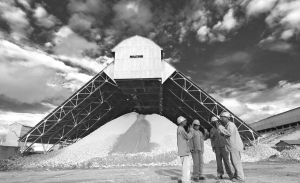Katanga Mining (KAT-T, KATFF-o) has stopped producing cobalt at two connected projects in the Democratic Republic of the Congo (DRC) because of falling prices for the metal.
The company says the move is temporary and that it won’t hurt its bottom line.
To avoid a loss in revenue, it will meet market demand for cobalt concentrate from stockpiles while mining at the cobalt-rich Tilwezembe open pit halts and the Kolwezi concentrator is shut down.
Tilwezembe sits 30 km southeast of Kolwezi and feeds the concentrator, which can turn out 655,000 tonnes of concentrate per year.
The concentrator was restarted in September 2006 by Katanga and had been running continuously until the recent announcement. Katanga expects to permanently decommission it once it gets its planned solvent extraction- elecrowinning refinery up and running.
Katanga has total proven and probable reserves of 310,000 tonnes cobalt at its projects, all located in the DRC’s Katanga province.
The company says it has 24,000 tonnes of cobalt concentrate as of the end of September. In the third quarter it sold just 7,000 tonnes, largely due to logistical issues, despite producing 14,588 tonnes.
In the first quarter of this year, the company generated US$90.2 million from cobalt concentrate sales, US$26.8 million in the second quarter and was down to US$17.2 million by the third.
BHP Billiton’s (BHP-N, BLT-l) most recent open cobalt sales reports show it to have sold 5 million tonnes of cobalt in October for US$36 per lb. In March, it was selling the metal for more than US$50 per lb.
Most cobalt is produced as a copper and nickel byproduct. The majority of demand comes from its use in rechargeable batteries, superalloys, dyes and pigments, catalysts and high-performance magnets.
As for Katanga’s other projects in the DRC, the company says operations at its flagship Kamoto copper and cobalt underground mine are continuing. The same, however, cannot be said for its Luilu metallurgical plant.
A transformer fire in early November shut the plant down for the better part of the month, although on Nov. 26 the company reported that it was up an running again.
At presstime, Katanga’s shares were trading at around 80 apiece. Its shares had closed as high as $18.21 in January.
Since then, the company’s stock has been hammered by the volatile markets, compounded by the fact that its operations are located in the risky DRC, which was gripped by civil war from 1998-2003.
While fresh violence in the eastern part of the country is more than 1,000 km away from Katanga’s operations, if the country were to teeter back into war, it would no doubt have negative consequences for miners throughout the copper region.
As for company specific issues, the global credit squeeze has it looking for ways to reduce capital spending, with some analysts believing that the second phase of production at Kamoto will have to be postponed.
In the midst of an atmosphere where real and perceived risks are growing, company chief executive Arthur Ditto announced he would resign from his post in July.
On the more stable side of things, Katanga was able to come to terms with DRC state-controlled miner Gcamines in negotiations connected with the ongoing mining contract renegotiation process — something neither Freeport-McMoRan Copper & Gold (FCX-n) nor First Quantum Minerals (FM-T, FQVLF-o) has yet been able to do.


Be the first to comment on "Katanga Halts Cobalt Production In DRC"